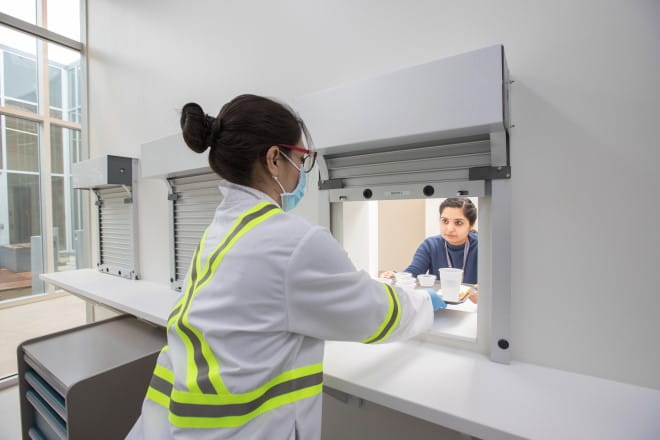
As our pea protein plant in Canada gets closer to producing product for customers, our Quality Team is hard at work making sure we consistently provide the highest quality pea protein. Part of this commitment to our customers includes building a team of employee sensory evaluators (panelists) who are being trained in an on-site program known as Sensory University.
Providing a sensory evaluation of our products is a lot more complicated than simply “taste testing.” Panelists learn to identify the flavors and intensity of the samples they try so they can describe the foods’ characteristics, for example, sweet, sour, bitter, salty and umami. (Umami means “essence of deliciousness” in Japanese, and its taste is related to an amino acid that is one of the building blocks of protein and it is often described as the meaty, savory deliciousness that deepens flavor.)
The sensory university is run by Martha Neudert Holguin (Laboratory Technologist) and Radhika Kapoor (Microbiologist). Martha says, “It is a great opportunity to learn and get to know our colleagues from different areas of Roquette that we wouldn’t meet in any other situation. It is also very interesting to realize that for some of them it is the first time that they have used their sense of taste in this way, and now they are very invested in learning more about sensory evaluation.”

Find out more in the Q&A below with Martha and Radhika about what panelists learn in their training and how they contribute to maintaining pea product quality in Canada.
Q. How many people is optimum to have trained up on sensory evaluation as part of normal plant operations?
To assess the product, we need 12 people present at the same time for each sensory test. It’s unlikely that 12 people will be available during a startup because some will be working on other priorities, in a different place, or even on holiday or leave. The method for sensory allows a minimum of four panelists to perform the test, but a higher number of panelists is recommended to ensure accuracy. Currently, we have 15 panelists that are ongoing with the sensory training.
Q. How many hours on average does it take to train a person on sensory?
Approximately 15 to 20 hours. Each test takes between 10 to 15 minutes to complete. Each panelist has to successfully pass each test 10 times. In total, they have to successfully pass 50 tests to graduate.
Q. What have been some of the challenges with the training from an organizational perspective?
Training a proficient panelist has its challenges because you are dealing with different panelists’ sensitivities. Given that we are getting ready for startup and commissioning, the availability of the panelists is limited, and they cannot attend all the training sessions. We constantly work to accommodate training at a time where the panelists are available, but the challenge is to coordinate accommodating fifteen different schedules that constantly change throughout the day.
Q. What feedback are participants giving you on the experience?
They enjoy performing the tests because it is the first time for most of them to use their sense of taste in this way. For some of them, it’s turned into a game in which they have to figure out which samples are the same (Pairing Test) or rank the samples from the weakest to the strongest intensity (Intensity Test).
Over time, we have seen the progress of the panelists identifying flavors and intensity. Some of them mentioned that when they go home and eat something, they try to identify the basic tastes (Sweet, Sour, Bitter, Umami, Salty) that they perceive in their food.
Because they have to repeat each test 10 times, we always try to surprise them to keep them engaged. Occasionally, we send entertaining messages to remind them to attend sensory, and some of the funniest reminders are the ones that bring the panelists smiling to perform the tests. After each session, the panelists look forward to the treats of all kinds (mostly chocolates) that we have available for them as a token of our appreciation.
Q. Of the 5 sensory basic tastes, which is proving to be most challenging for your students? How do you help them achieve success?
The most difficult test is Intensity test for sweetness. Some panelists consume very sweet food products, and they became accustomed to higher sugar concentrations. We believe this is the reason that it is challenging to identify the order of the weakest (lowest concentration) samples. We provide 1-on-1 sessions where we guide and advise the panelists of the best practices to perform sensory tests.
Q. Why is it important for Roquette in Canada to have a dedicated and trained team of sensory evaluators?
This team helps ensure that our products continually meet the high-quality standards and meet our client’s expectations. Also, because we are a secondary plant producing pea protein within the company, we need to ensure that we are producing a consistent product with our sister plant Vic-sur-Aisne in France.
Photo caption: Martha Neudert Holguin passing a sensory evaluation tray to participant Navjot Kaur.
Other photo: Sensory lab
Search NUTRALYS® plant protein ingredients, get quality documents and request samples for your trials.
Your success is our greatest priority, and your needs are unique. We would love to better understand your needs and connect you with our experts.















